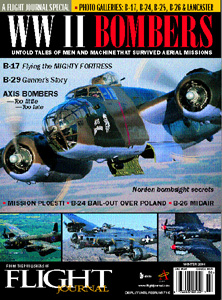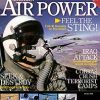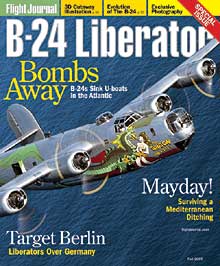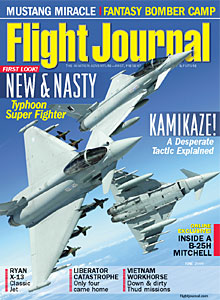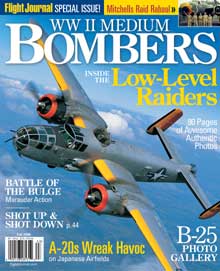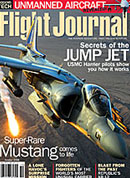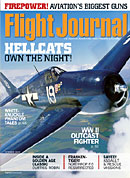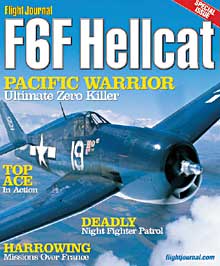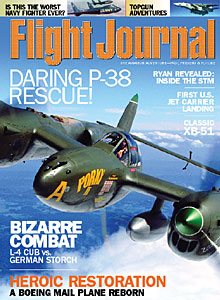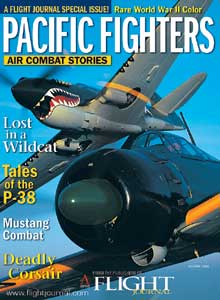WWII Bombers
$7.99
| In the Theater Douglas A-20/DB-7 Stan Piet The A-20 Havoc was designed to fulfill an Air Corps requirement for a speedy, twin-engine attack bomber. Deliveries began in December 1940, and a year later when Pearl Harbor was bombed, the A-20 immediately went to war, first in the Pacific, and then later in North Africa. Stan Piet takes a brief look at the history of this early American WW II bomber. | |
The Rugged Fortress Life-Saving B-17 Remembered Robert W. Browne The B-17 had a well-deserved reputation for being rugged and versatile, and it seemed no number of bumps and bruises could ground a Flying Fortress for long. Robert Browne, who flew the B-17 towards the end of the War in Europe, looks back at his piloting days. With sincere affection for his former plane, Browne shares both humorous and gripping anecdotes from his time stationed in England. | |
Photo Gallery The B-24 Liberator Robert F. Dorr During the Second World War, the B-24 Liberator was a vital component of the Allied victory. Nevertheless, the plane never seems to have gotten its proper recognition, as it flew in the shadow of its older sister, the B-17 Flying Fortress. The B-24, however, was faster, carried more bombs, and traveled farther. Robert Dorr takes a look at the history of this under-appreciated, yet crucially important, WW II bomber, with the help of a montage of authentic photographs. | |
A Shot in the Dark Former Enemies Meet 55 Years Later Christopher Stuart A few days after D-Day, the paths of Luftwaffe fighters Kurt Sch”nfeld and Dieter Schmidt crosses that of British airman Gerald Martin in the skies above Holland as Schmidt shoots down Martin’s Lancaster, killing several of his fellow crew members on their last mission of the war. A long chain of events brings the men together again 55 years later, when the former enemies meet in the Netherlands with the opportunity to put the past aside and become friends. Christopher Stuart shares a story of suspense and human nature that spans more than five decades. | |
B-29 Stories High-Altitude Payback Chester Marshall When the B-29 Superfortress debuted in combat, it was hailed as the most advanced military aircraft ever built, and, as the next number of years would prove, it managed to live up to that reputation. Through firsthand accounts and personal experience, Chester Marshall, who flew 30 combat missions in the B-29, looks at the history of the Superfortress, and the invaluable role that it played in the Pacific during WW II. | |
Photo Gallery The Boeing B-17 Flying Fortress Walter Boyne The B-17 “”looked right”” as soon as it was unveiled in 1935. Production started slowly, but shot upwards as the threat of war loomed ever closer. The Flying Fortress was constantly being adapted to keep up with the changing times, and it reached its peak with the powerful B-17G. Walter Boyne examines the history of one of the most recognizable crafts of all times, and presents a full gallery of WW II photographs which depict the B-17 in its heyday. | |
In the Theater North American B-25A Stan Piet The B-25 is remembered as being the Army Air Force’s most successful WW II medium bomber. Although the first B-25s that took to the sky were lightly armed and had fixed, hand-operated machine guns, combat reports quickly dictated changes that, when implemented, saw the B-25 become an amazing weapon. The B-25 will always be remembered, however, for serving as the plane that Jimmy Doolittle and Doolittle’s Raiders used to bomb Japan in April 1942. | |
Miracle at Beauvais Surviving a Midair Collision Charles O’Mahoney Charles O’Mahony, a B-26 pilot during WW II, recalls a terrible tragedy that occurred in the air over France on St. Patrick’s Day 1945. During a routine flight exercise, three B-26s collided in midair. Of the 19 men aboard those three aircraft, 18 died, while the last one – pilot Alex Cordes – miraculously survived unhurt. It was determined that the catastrophe was the result of pilot error on the part of one of the deceased, who had been a “”short-timer.”” O’Mahony uses this tale to remind us of the often-unknown dangers of formation flying, which have resulted in numerous unnecessary deaths. | |
Bomber Restoration Last of its Kind ; B-29 Restoration to Flying Status Here, two legendary crafts are examined. First, “”Flight Journal”” takes a look at the only B-26 that remains airworthy today. Formerly piloted by Lt. Col. Howard Smiley, this craft is housed at Kermit Week’s Fantasy of Flight in Polk City, Florida. Secondly, the massive restoration effort of a B-29 by former and current Boeing employees is inspected. | |
Strategic Bombing Success of Failure? Barrett Tillman While tactical air strikes targeted specific things, a strategic bombing mission is one that is defined as simply dropping bombs on a large area and destroying everything nearby. As conceived by Italian general Guilo Douhet, the initial rationale behind this bold move was to damage the morale of people who knew that, as long as hostilities continued, they would continue to be bombed. Morale isn’t the only thing that takes a hit during bombing; the economy also suffers terribly. However, the ghastly price of this bombing is private property and human lives. Barrett Tillman traces the history of strategic bombing, from WW I to the Gulf War, and examines if the dividends it pays are worth the price of the innocent citizenry that suffers. | |
Photo Gallery The Avro Lancaster Dan Patterson After the British Army had been ejected from France, Winston Churchill turned his attention to finding an offensive weapon with which to strike at Hitler. Developed from the disappointing Manchester – a twin-engine bomber that failed to live up to expectations –the Lancaster became Britain’s most successful bomber. Unfortunately, between 1939 and 1945, despite its successes, the loss rate of Lancasters and their crews were inordinately high. | |
B-24 “”Bailout!”” Not in the Travel Brochure? Robert G. DeGroat Robert G. DeGroat shares the thrilling story of his final B-24 flight. Flying from Italy to Poland on an incredibly long mission in December of 1944, DeGroat and his crew were forced to bail out of their plane high over Russian territory. The author recalls that landing in Russia was not advised, but being picked up by the Russians would be better than being discovered on the ground by the Germans. As it happened, DeGroat landed dangerously close to the front lines. | |
Norden Bomb Sights The Pickle Barrel War Barrett Tillman Developed by Carl Norden and Theodore Barth, the revolutionary Norden bombsight was found in the nose of every WW II U.S. Army bomber, as well as in many Navy aircraft. Although it was to gain fame in B-17s, B-24s, and B-29s, the sight was first deployed in naval torpedo planes before WW II. As successful as the sight eventually became, it took years of development to perfect. For the U.S., maintaining the secrecy of the sight was an utmost priority, and bombardiers had to sign an oath that the sight would not fall into enemy hands. Military historian Barrett Tillman traces the history of this legendary component of WW II bombers that played a crucial role in the course of the war. | |
Terrifying Mission to Ploesti The Weather was as Deadly as the Flak Roger S. McCollester B-24 pilot Robert McCollester recalls a bombing mission he flew in 1944 to Romania. Having survived the flak attacks, McCollester figured he was home free. Of course, he never considered the possibility that it would be the weather, not the flak, that caused the greatest problems that day. With an eye for details, McCollester recounts specifics of that March 1944 mission, and recalls the dangers posed by something as simple as a few storm clouds. | |
Bomber Defense The Myth & Reality Donald Nijboer The introduction of the B-10 in 1932 marked the launch of the model from which all subsequent bombers were built. Bombers such as the B-10 began a trend that led to the development and widespread use of the powered turret in WW II. Donald Nijboer takes a close look at the development of bombers and turrets, as well the methods that bombers used to protect themselves throughout the Second World War. Specifically, examining RAF, USAAF, and Luftwaffe crafts, Njiboer also offers reflections on the diminished role of turrets and gunners following WW II, as bombers turned their attention towards electronic countermeasures, and eventually stealth technology, to protect themselves. | |
V-E Day Party Marauder Pilot Meet Bulge Survivors in Brussels John Christopher Dinou B-26 pilot John Dinou recalls with humor his actions immediately following the announcement of the European cease-fire, which he heard on a French radio broadcast. Dinou recalls the immense feelings of elation and relief that he and his fellow pilots felt, and recalls immediately hightailing it to Brussels to celebrate the end of the war. There he met up with several ground troops, whose stories add a poignant sense of wartime tragedy to this otherwise heart-warming and humorous tale of a young man at the end of war. | |
Axis Bombers Failed Promise Barrett Tillman Almost immediately on the heels of WW I, German officials began brainstorming, trying to come up with improvements that could be made in bombing techniques. Despite this jumpstart on the Second World War, Germany and its Axis allies never saw their bombers live up to their potential. Through tactical mismanagement and technical blunders, Japanese and German bombers proved, for the most part, ineffective, and Italian bombers had virtually no effect on the course of the war whatsoever. German attempts to improve their bomber fleets during the war were a typical example of too little, too late. Barrett Tillman examines the history of the Axis bombers, and traces the causes of their overall failures. | |
On Final A Call for Pilots and Crews Stan Piet In the late 1930s, an isolationist America suddenly realized that war was brewing in Europe, and, after years of focussing on improving economic conditions at home, President Roosevelt shifted his attention to a rapid revitalization of our armed forces. By the thousands, recruits from all walks of life were pushed through training programs on their way overseas. Unfortunately, as the war drew on, many “”green”” pilots were fed into the expanding airwars, and thousands lost their lives. |

